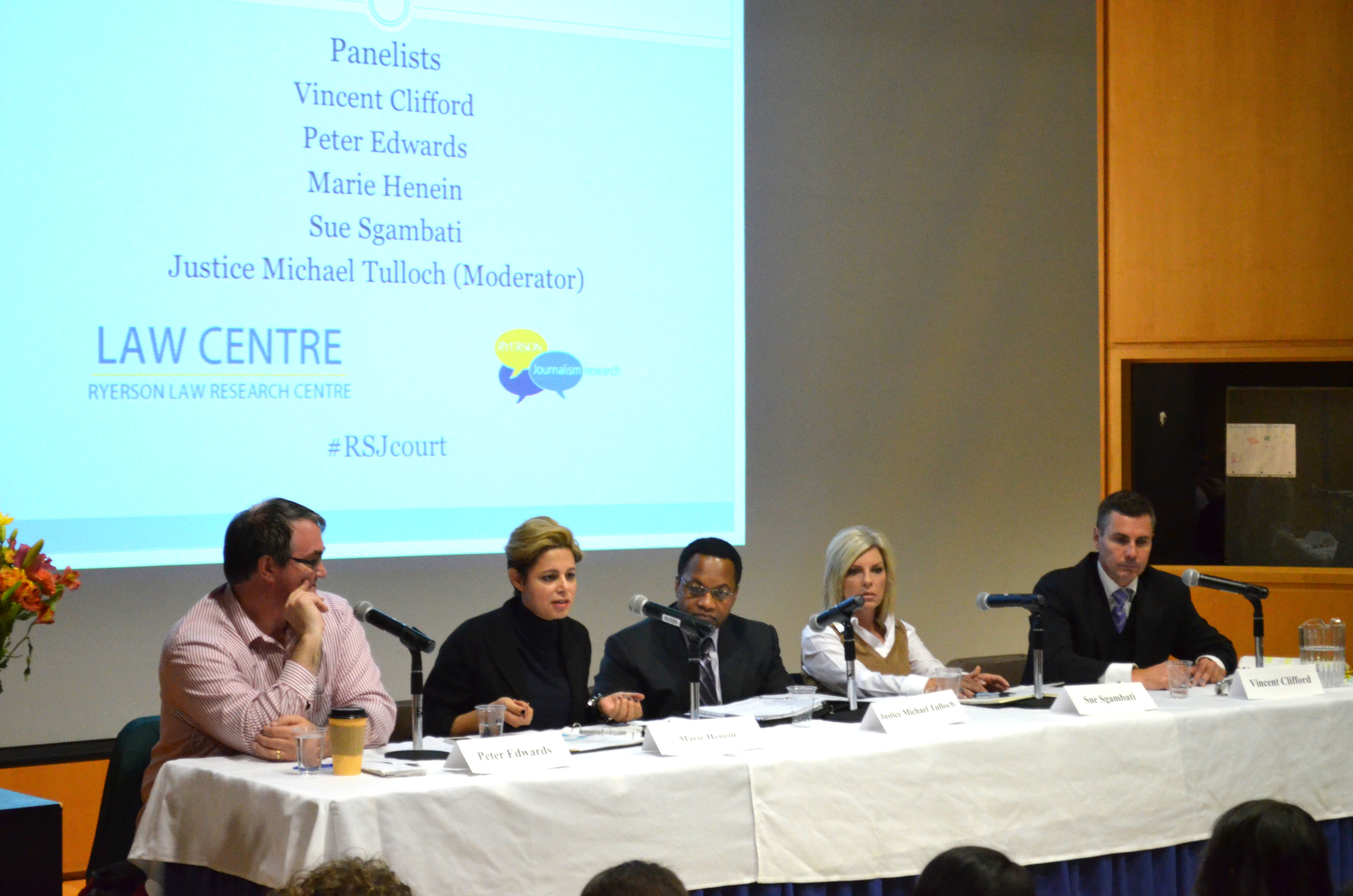By JACKIE HONG
STAFF REPORTER

The quality of news reporting on major trials can be undermined by something as basic as shortages of courtroom seating, a veteran crime reporter said during a recent panel discussion at the Ryerson University School of Journalism.
“When I get a high-profile case, the first thing I worry about is, ‘Will I get a seat?’” Peter Edwards, the Toronto Star’s organized crime and justice reporter, told more than 200 students, faculty and lawyers attending the September 26 event. Courtroom spectators must be seated during a trial if they want to remain in the room.
“Sometimes I have to run out and have a talk to my editors, I don’t want somebody to come butting in and take where I was,” Edwards said.
Covering Courts: Is Justice Served? was organized by the Ryerson Law Research Centre and the Ryerson Journalism Research Centre. In addition to Edwards, the other speakers included Sue Sgambati, crime specialist with CP24, and defence lawyers Marie Henein, from Henein and Associates, and Vincent Clifford, from Edelson Cifford D’Angelo Barristers LLP. The panel was moderated by Justice Michael Tulloch, a judge at the Ontario Court of Appeal and a former defence lawyer.
Students aided in broadcasting a live stream of the event online, and many also live-tweeted the discussion as it unfolded.
Sgambati said reporting on trials is difficult because bad acoustics and inadequate courtroom sound systems mean reporters often can’t hear what’s being said. Court officials are also still erratic when it comes to allowing reporters to use electronic devices inside the courtroom. She recalled how, before Mayor Rob Ford’s conflict of interest trial in September, there was a debate as to whether reporters would be able to use technology in court.
“Why are we having this discussion? [Voice recorders and smartphones] are the modern-day pen and notepad,” Sgambati said, observing that social media networks like Twitter are central to reporting on unfolding events. Banning the use of smartphones means tweeting live updates on trial proceedings is impossible to do from inside the courtroom.
Edwards said the ability of reporters to report quickly and accurately on what’s happening in the courts is also hampered by unpredictable access to copies of documents and other exhibits presented in court. They are often at the mercy of lawyers or court reporters who may – or may not – be helpful.
“In 2012, I don’t see why we should have to… curry favour, play personalities [of attorneys and clerks] to get exhibits,” Edwards said. One solution, he said, would be for court officials to create a password-protected online cache of exhibits that would be easy for all reporters to access.
Clifford said that the cache would also help the lawyers on the receiving end of journalists’ requests for access to exhibits. He recalled a case he worked on where, in single day, his team received nine requests by members of the media for copies of different documents.
“You just don’t want to spend the day dealing with something that’s completely unnecessary,” he said.
Henein said lack of funding explains a lot of the problems that undermine accurate news reporting of court proceedings.
“Reserved seating for the media, standardized press cards, a proper sound system, electronic access so we can all access the exhibits, those are basic things [that courts should have]. Unfortunately, it is a financial limitation,” she said.
Henein also highlighted the conflicting roles of journalists and lawyers in court. The news media may choose to publish sensational details while lawyers focus on less attention-grabbing but more legally significant points.
“Is justice served by seeing Colonel Russell Williams in lingerie? Probably not,” Henein said, referring to the former Canadian Air Forces officer who, in 2010, was convicted of murdering two women, sexually assaulting and forcibly confining two other women, and over 80 breaking-and-entering charges. Controversial and disturbing photos of Williams wearing stolen panties and bras were published in several major publications, including the Toronto Star and Globe and Mail, a day after they were presented as evidence on the first day of Williams’ trial.
All the speakers emphasized the important role that news reporting about the courts plays in society.
“The average person… knows absolutely nothing about our justice system, and so they’re going to be relying on [journalists] who’re reporting courts to convey to them not only a sensational story, really, but the truth of what happens within the system,” Tulloch said.
